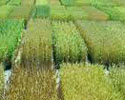
Influence of various tillage option along with nutrient management practices in maize –wheat cropping system under mid hill situation of West Bengal
Abstract
Keywords
Full Text:
PDFReferences
Acharya CL, Bandopadhyay KK, Efficient input management for sustainable production. Indian Farm, 2002, 52, 42-49.
Auti AK, Wadile SC, Pawar VS, Yield, quality and nutrient removal of wheat (Triticum aestivum) as influenced by levels and sources of fertilizers. Indian J of Agron,1999, 44, 119-122.
Gangaiah B, Ahlawat IPS, Shivakumar BG, Crop rotation and residue recycling effects of legumes on wheat as influenced by nitrogen fertilization. Agric Scie Res J, 2002, 2(4), 167 – 176.
Gaur BL, Performance of improved technologies of rain fed maize in on-farm trials of watershed area. Indian J of Dryland Agric Res and Development, 2002, 17, 74-75.
Gomez KA, Gomez AA, Statistical Procedures for Agric Res. 2nd Edition. John Wiley & Sons, New York, USA, pp. 1988, 392–395.
Jackson ML, Soil chemical analysis. Prentice Hall of India Pvt. Ltd., New Delhi, 1973, pp 67-75.
Jaga PK, Upadhyay VB, Effect of integrated nutrient management on wheat – A review. Innovare J of Agric Scie, 2013, 1(1),1-3.
Kumar A and Thakur KS, Effect of integrated nutrient management on promising composite maize (Zea mays) varieties under rain-fed mid-hill conditions of Himachal Pradesh. Indian J of Agric Scie, 2004, 74: 40-42.
Lal R, Mohboubi A, Fausey NR, Long-term tillage and rotation effects on properties of central Ohio soils. Soil Scie Soc of American J, 1994, 58, 517–22.
Limon-Ortega A, Sayer KD, Francis CA, Soil attributes in a furrow- irrigated bed planting system in northwest Mexico. Soil Tillage Res, 2002, 63, 123–32.
Mandal B, Ray DP, Hansda AK, Application of resource conserving technology (RCT) in wheat: A promising better option particularly during winter season in West Bengal. International J of Bioresource Scie, 2014, 1 (1), 7-17.
Mehmood Y, Muhammad BA, Muazzam S, Muhamad A, Benefit cost ration of organic and inorganic wheat production: A case study of district sheikhupura. World Applied Sciences Journal, 2011, 13 (1), 175-180.
Mukherjee D, Sustainable hill agriculture through organic farming. Himalayn Times, 2012, 4 (5), 20-21.
Munda GC, Islam M, Nath LK, Integrated nutrient management approach for enhancing productivity and economics of maize (Zea mays L) –toria (Brassica campestris L) cropping system. Agric Scie Digest, 2011, 31(3), 188-192.
Olsen SR, Cole CV, Watanabe FS, Dean LA, Estimation of available phosphorus in soils by extraction with sodium bicarbonate. USDA Circ. No. 939, Washington, 1954, 46-49.
Patil SL, Sheelavantar MN, Yield and yield components of rabi sorghum (Sorghum bicolour) as influenced by in-situ moisture conservation practices and integrated nutrient management in vertisols of semi-arid tropics of India. Indian J of Agro, 2000, 45, 132- 137.
Prasad R, A Practical Manual for Soil Fertility. Division of Agronomy, Indian Agricultural Research Institute, New Delhi, 1998, 50.
Sakthivel N A, Balasubramanian S R, Subbian P. Effect of in situ moisture conservation practices and intercropping system on yield of rain-fed maize in western zone of Tamil Nadu. Madras Agric J, 2003, 90, 411-415.
Tetarwal JP, Baldev R, Meena DS, Effect of integrated nutrient management on productivity, profitability nutrient uptake and soil fertility in rain fed maize (Zea Mays). Indian J of Agron, 2011, 56 (4): 373-376.
Copyright (c) 2015 Annals of Plant Sciences

This work is licensed under a Creative Commons Attribution-NonCommercial-NoDerivatives 4.0 International License.


